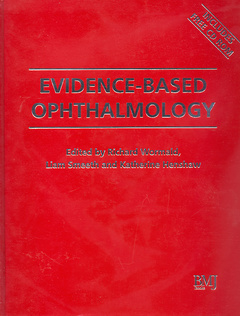Description
Evidence-based ophthalmology
Includes Free CD-ROM
Evidence–Based Medicine Series
Coordinators: Wormald Richard, Henshaw Katherine, Smeeth Liam
Language: English
Subjects for Evidence-based ophthalmology:
Publication date: 10-2003
414 p. · 21.7x27.8 cm · Hardback
Out of Print
414 p. · 21.7x27.8 cm · Hardback
Out of Print
Description
/li>Contents
/li>
This text discusses the application of evidence-based principles in opthalmic practice. The clinical section goes on to provide an overview of the evidence for optimum management in the key areas. It draws on the expertise of ophthalmologists working in evidence-based medicine worldwide.
Part I - The basics: finding the evidence, synthesizing the evidence, putting the evidence into practice. Part II - Overview of the evidence in key areas: allergic conjunctivitis, screening in the elderly in primary care, congenital cataract, congential glaucoma, retinopathy of prematurity, opthalmia neonatorum, amblyopia, squints, prevention of myopia progression, vitamin A and measles, entropian and ectropion, thyroid eye disease, lacrimal obstruction, trachoma, abrasion and recurrent erosion, herpes simplex keratitis, suppurative keratitis and acanthamoeba, toxoplasma and toxocara, onchocerciasis, autoimmune syndromes, herpetic anterior uveitis, CMV retinitis, acute retinal necrosis, primary open angle glaucoma, angle closure glaucoma, secondary glaucoma, surgical techniques and aphakic correction, surgery in developing countries, intraocular lenses, multi-focal lenses, perioperative management, age-related macular degeneration, lattice degeneration and retinal breaks, surgery for proliferative vitreo-retinopathy, retinal detachment, macular hole, retinal vein occulsion and artery occulsion, effects of diabetes and blood pressure control on diabetic retinopathy, effectiveness of screening and monitoring tests for diabetic retinopathy, pharmacological interventions in diabetic retinopathy, surgical interventions and laser treatment in proliferative diabetic retinopathy, surgical interventions and laser treatment in diabetic macular oedema, optic neuritis arteritic and non-arteritic ischaemic optic neuropathy, idiopathic intracranial hypertension, compressive optic neuropathy, heredofamilial toxic and nutritional optic neuropathy, traumatic optic neuropathy, lid and orbital cancers, uveal melanoma, retinoblastoma, low vision aids and eccentric viewing training, mobility training psychosocial interventions and activities of daily living.
© 2024 LAVOISIER S.A.S.




